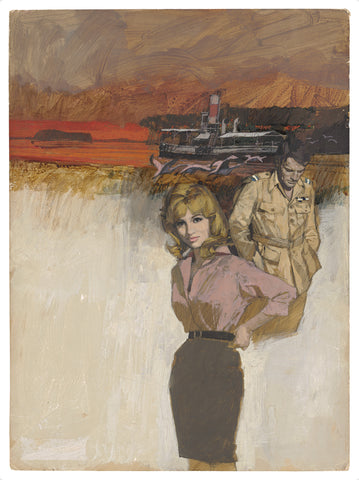Renato Fratini (Civitavecchia, Oct, 1932 - Mexico, 1973) enjoyed a successful career producing illustration for film posters, comic strips, book covers, magazine and advertising commissions during the 1950s in Italy and throughout the thriving creative scene of 1960s London. An exuberant character, he enjoyed all that social London had to offer during a life that ended tragically early.
Early Life and Influences
Fratini was born in a port town just outside of Rome, called Civitavecchia in 1932. Fratini studied at the Accademia di Belle Arti de Roma, before beginning his career as a commercial artist in Rome the 1950s. He began work at the Guerri brothers studio, initially producing illustrations and comic strips. In 1952, he moved to the Favalli brothers’ studio, where he first began creating film posters and book covers - the two formats that would go on to define his career. At this time, the Favalli brothers ran the publicity department at Rome’s Cinecitta Studios, making them the world’s most prolific producers of film posters. Fratini produced some iconic posters during this period, for a number of iconic American and Italian films, such as Invaders from Mars (1953), La Donna Piu Bella Del Mondo (1955) and The Sweet Smell of Success (1957).
In the late 1950s, the Favalli brothers’ studio collapsed following the death of one of the brothers, and so Fratini began working for the Milan based company, D’Ami studio set up by two brothers in 1954. Roy D’Ami was an illustrator and Piero D’Ami provided the capital. Fratini was commissioned to paint a number of book covers, all for Fleetway Publications, a magazine publishing company based in London and one of the largest clients of the D’Ami studios. Fratini illustrated a number of covers for the Sexton Blake series, a famous fictional British detective of this period, who appeared in comic books and novels throughout the 20th century. Towards the end of the 1950s, the D’Ami brother fell out and work began to dry up, causing a number of their represented artists to find work elsewhere. London was the destination of choice for most.
In 1958, Fratini was brought to London by Eric Pulford, a commercial artist who had set up a design studio in London in 1943. Pulford had previously worked with Fratini when in Italy when he worked for Studio Favalli. Pulford Publicity was supported by the film company, Rank and the Fleet Street agency, Downton Agency. Rank, Downton Agency and Pulford Publicity worked with the largest film studios. In this era when print was the primary form of film promotion Pulford Publicity was responsible for more than 1000 film poster designs. When Pulford invited Fratini to London, he quickly found his feet, entering the most productive period of his career.
Illustrative Style
Whilst in London, Fratini continued to produce film posters mainly commissioned by Eric Pulford on which they collaborated closely. Pulford would specify the design, layout and graphics with Fratini introducing distinctive illustration to the composition. There is a bold, graphic quality to his work that is very characteristic of Sixties art.
During this period in London, Fratini also began working on book covers and magazine illustrations. Fratini’s filmic style translates across all of his work. His illustrations are characterised by narrative elements that tell a story in their own right. Fratini’s illustrations would capture the essence of the film or book and in the process create a unique artwork. Before artists like Fratini, film posters would often simply depict a scene from the film and be fairly formulaic. After Fratini, film poster illustration attempted to capture the essence of the film, establishing a visual style definitively associated with each film.
The narrative element of his work is also a reflection in his success as a comic strip artist, which continued throughout his career. In the late 1950s, he was commissioned work on a number of covers for the Sexton Blake comic and novel series. In 1965, he was also asked to work on Modesty Blaise, for King magazine, over four issues. Modesty Blaise, a long running British newspaper cartoon, followed the adventures of a fictional action heroine in her spoof spy-fi adventures.
In addition to the strong narrative elements, Fratini artwork has an almost tangible sense of atmosphere, which helps explain his popular appeal. Fratini also experimented with mixed media to create contrast and texture which adds depth and intrigue. He would often create the background in acrylic and then use mixed acrylic inks over the top and finish with gouache.
Work and Connections
Fratini created film posters for From Russia With Love (1963), Whistle Down the Wind (1961) and Phantom of the Opera (1962). He also produced a number of posters for the hugely popular Carry On films. This series of 31 low-budget British comedy films are still the largest British film series to date. During this period, Fratini was earning around £1000 per poster. This was at a time when the average yearly wage for most men was £18 a year. His career flourished throughout the 1960s, until his highest paying film poster for Waterloo (1970), for which he earnt £2000.
Fratini worked for a number of London publishers, such as Coronet, Hodder, Corgi and Pan. He was commissioned by the legendary art director, Germano Facetti at Penguin to create new covers for the best selling romance novels, Daphne du Maurier novels. A number of du Maurier’s novels were turned into memorable films, including Rebecca, directed by Alfred Hitchcock. Fratini produced a number of covers for other historical romance novels by authors such as Catherine Gaskin, Victoria Holt and Norah Lofts.
Fratini also had regular work as a magazine illustrator for journals such as Homes and Garden, Woman’s Journal and Woman. His first UK commission was a double page spread for Woman’s Mirror in 1963.
Lifestyle
Fratini thrived on the London art and party scene of the 1960s. He married fashion designer, Gina Fratini in 1961. Gina described him as someone who had an exuberance for life: "He loved food, loved drink, loved cigars, loved dancing ... he just liked to generally live it up. He adored jazz, and we were always out at Ronnie Scott’s." He died in 1973 in Mexico, at the age of just 41.





















